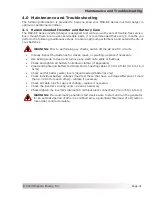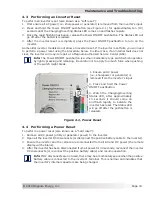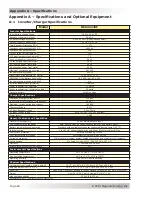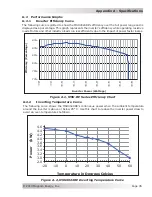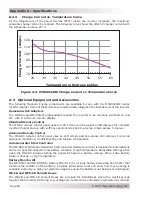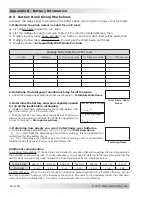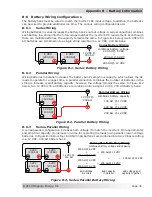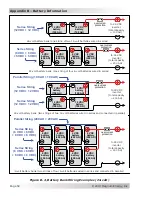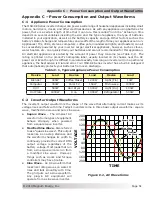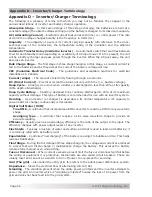
Page 52
Appendix D – Inverter/Charger Terminology
Appendix D – Inverter/Charger Terminology
The following is a glossary of terms with which you may not be familiar. They appear in the
various descriptions of inverter and battery charger operation.
Absorption Stage
– In this second stage of three stage charging, the batteries are held at a
constant voltage (the absorb voltage setting) and the battery is charged to its maximum capacity.
AC (Alternating Current)
– Electrical current that varies with time (i.e., utility power). The rate
at which the voltage changes polarity is the frequency in Hertz (Hz).
Ampacity
– The ampacity of a wire is its current carrying capacity with reference to the cross-
sectional area of the conductors, the temperature rating of the insulation and the ambient
temperature.
Automatic Transfer Relay (inside the inverter)
– An automatic switch that switches between
Inverter and Standby mode depending on availability of AC input power. If AC is present, the unit
will be a battery charger and pass power through the inverter. When the AC goes away, the unit
becomes an inverter.
Bulk Charge Stage
– The
fi
rst stage in three stage charging. In this stage, a constant current is
fed to the batteries and as they accept the current the battery voltage will rise.
CEC
(Canadian Electrical Code)
– The guidelines and acceptable practices for electrical
installations in Canada.
Current (Amps)
– The amount of electricity
fl
owing through a conductor.
DC (Direct Current)
– Electrical current that does not vary with time (i.e., battery voltage).
Deep Cycle
– A deep cycle occurs when a battery is discharged to less than 20% of its capacity
(80% depth-of-discharge).
Deep Cycle Battery
– A battery designed to be routinely discharged to 20% of its maximum
capacity without damage. This type of battery is recommended for use with an inverter system.
Derating
– As an inverter (or charger) is used above its normal temperature, it’s capacity to
power loads (or charge) continuously is decreased.
Digital Volt Meter (DVM)
:
True RMS
– A voltmeter that incorporates a RMS converter to read true RMS for any waveform
shape.
Averaging Type
– A voltmeter that requires a sine wave waveform shape to provide an
accurate reading.
Effi ciency
– Usually given as a percentage, ef
fi
ciency is the ratio of the output to the input. The
ef
fi
ciency changes with power output levels of any inverter.
Electrolyte
– Typically a mixture of water and sulfuric acid that is used in lead-acid batteries; it
is commonly referred to as battery acid.
Equalization
– Controlled “overcharging” of the battery causing it to bubble and mix. This helps
reduce strati
fi
cation.
Float Stage
– During the third stage of three stage charging, the voltage and current are reduced
to a level that will trickle charge or maintenance charge the battery. This assures the battery
remains fully charged even while sitting.
Fuse or Disconnect
– When current exceeds a preset limit the fuse or disconnect will fail before
the wiring or equipment it is protecting. Disconnects are also called circuit breakers. These are
usually reset and can act as a switch to turn off power to equipment for servicing.
Grid (The grid)
– Also called the utility grid, this refers to the public power distribution system.
Impedance
– Slows the electrical
fl
ow of alternating current (AC).
Islanding
- The condition present when the utility power grid fails and the inverter attempts to
power the grid. An inverter which is “islanding protected” senses the loss of AC power from the
grid and does not back feed into the grid system.




